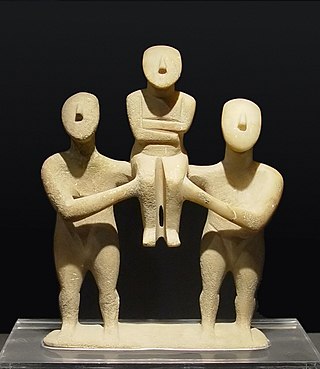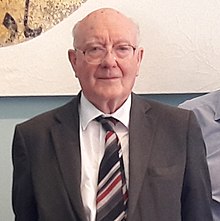
Nostratic is a hypothetical language macrofamily including many of the language families of northern Eurasia first proposed in 1903. Though a historically important proposal, it is now generally considered a fringe theory. Its exact composition varies based on proponent; it typically includes the Kartvelian, Indo-European and Uralic languages; some languages from the similarly controversial Altaic family; the Afroasiatic languages; as well as the Dravidian languages.

The Proto-Indo-Europeans are a hypothetical prehistoric ethnolinguistic group of Eurasia who spoke Proto-Indo-European (PIE), the reconstructed common ancestor of the Indo-European language family.

Marija Gimbutas was a Lithuanian archaeologist and anthropologist known for her research into the Neolithic and Bronze Age cultures of "Old Europe" and for her Kurgan hypothesis, which located the Proto-Indo-European homeland in the Pontic Steppe.
Old Europe is a term coined by the Lithuanian archaeologist Marija Gimbutas to describe what she perceived as a relatively homogeneous pre-Indo-European Neolithic and Copper Age culture or civilisation in Southeast Europe, centred in the Lower Danube Valley. Old Europe is also referred to in some literature as the Danube civilisation.

The Kurgan hypothesis is the most widely accepted proposal to identify the Proto-Indo-European homeland from which the Indo-European languages spread out throughout Europe and parts of Asia. It postulates that the people of a Kurgan culture in the Pontic steppe north of the Black Sea were the most likely speakers of the Proto-Indo-European language (PIE). The term is derived from the Turkic word kurgan (курга́н), meaning tumulus or burial mound.
Cognitive archaeology is a theoretical perspective in archaeology that focuses on the ancient mind. It is divided into two main groups: evolutionary cognitive archaeology (ECA), which seeks to understand human cognitive evolution from the material record, and ideational cognitive archaeology (ICA), which focuses on the symbolic structures discernable in or inferable from past material culture.
The year 1991 in archaeology involved some significant events.

The Ezero culture, 3300—2700 BC, was a Bronze Age archaeological culture occupying most of present-day Bulgaria. It takes its name from the Tell-settlement of Ezero.

The Anatolian hypothesis, also known as the Anatolian theory or the sedentary farmer theory, first developed by British archaeologist Colin Renfrew in 1987, proposes that the dispersal of Proto-Indo-Europeans originated in Neolithic Anatolia. It is the main competitor to the Kurgan hypothesis, or steppe theory, which enjoys more academic favor.

Sitagroi is a village and a former municipality in the Drama regional unit, East Macedonia and Thrace, Greece. Since the 2011 local government reform, it is part of the municipality Prosotsani, of which it is a municipal unit. The municipal unit has an area of 62.890 km2. Population 3,240 (2021). The seat of the municipality was in Fotolivos.
Christopher John Scarre, FSA is an academic and writer in the fields of archaeology, pre-history and ancient history. He is Professor of Archaeology at the University of Durham and was head of its archaeology department 2010-2013.
Steven Mithen, is an archaeologist. He is noted for his work on the evolution of language, music and intelligence, prehistoric hunter-gatherers, and the origins of farming. He is professor of early prehistory at the University of Reading.
Paul Gerard Bahn, is a British archaeologist, translator, writer and broadcaster who has published extensively on a range of archaeological topics, with particular attention to prehistoric art. He is a contributing editor to Archaeology magazine. With Colin Renfrew, he wrote the popular archaeology textbook Archaeology: Theories, Methods and Practice.

The pre-Indo-European languages are any of several ancient languages, not necessarily related to one another, that existed in Prehistoric Europe, Asia Minor, Ancient Iran and Southern Asia before the arrival of speakers of Indo-European languages. The oldest Indo-European language texts are Hittite and date from the 19th century BC in Kültepe, and while estimates vary widely, the spoken Indo-European languages are believed to have developed at the latest by the 3rd millennium BC. Thus, the pre-Indo-European languages must have developed earlier than or, in some cases, alongside the Indo-European languages that ultimately displaced almost all of them.

Due partly to the fact that this took place before the written record of this region began, there have been a number of theories presented over the years to fill the gap of knowledge about how and why the end of the Cucuteni–Trypillia culture happened. These theories include invasions from various groups of people, a gradual cultural shift as more advanced societies settled in their region, and environmental collapse.

The Keros-Syros culture is named after two islands in the Cyclades: Keros and Syros. This culture flourished during the Early Cycladic II period of the Cycladic civilization. The trade relations of this culture spread far and wide from the Greek mainland to Crete and Asia Minor.
Jane Renfrew, Lady Renfrew of Kaimsthorn is a British archaeologist and paleoethnobotanist noted for her studies on the use of plants in prehistory, the origin and development of agriculture, food and wine in antiquity, and the origin of the vine and wine in the Mediterranean.
Neuroarchaeology is a sub-discipline of archaeology that uses neuroscientific data to infer things about brain form and function in human cognitive evolution. The term was first suggested and thus coined by Colin Renfrew and Lambros Malafouris.
The Sapient paradox is a question that can be formulated as "why there was such a long gap between emergence of genetically and anatomically modern humans and the development of complex behaviors?" Homo sapiens emerged as a species somewhere between 60,000 and 100,000 years ago, but the behaviour that is associated with modern humans began to emerge and accelerate only 10,000 years ago. The question was first formulated by archaeologist Colin Renfrew in 1996.
Lambros Malafouris is a Greek-British cognitive archaeologist who has pioneered the application of concepts from the philosophy of mind to the material record. He is Professor of Cognitive and Anthropological Archaeology at the University of Oxford. He is known for Material Engagement Theory, the idea that material objects in the archaeological record are part of the ancient human mind.









